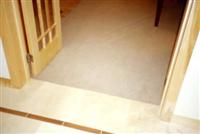 It is not just because of the housing collapse that many seniors have decided to stay in their existing homes instead of moving into a senior community in recent years. It also is because it is easier to make home changes to keep up with the needs of older adults who wish to “age in place.” In this two-part series, I am going to take you on a walking tour of an older adult’s home with an eye to how to make life a bit easier and safer. If you are a caregiver to an older adult or someone else with special needs, think of it as a checklist room by room.
It is not just because of the housing collapse that many seniors have decided to stay in their existing homes instead of moving into a senior community in recent years. It also is because it is easier to make home changes to keep up with the needs of older adults who wish to “age in place.” In this two-part series, I am going to take you on a walking tour of an older adult’s home with an eye to how to make life a bit easier and safer. If you are a caregiver to an older adult or someone else with special needs, think of it as a checklist room by room.
Front Door. Don’t think of those few steps that lead up to the front door as a stairway; think of them as barriers to entry and exit. Recall from an earlier post that osteoarthritis becomes increasingly common with age, and what used to be four easy steps can now become a big challenge. Then, add an armful of groceries or a dark night when things are not as easy to see clearly, and you have an accident waiting to happen. Consider as alternatives either a no-step rehab to the entry way or a long ramp; I say long ramp, because it is important to keep the grade modest to accommodate a wheelchair, a walker, crutches or a cane. And get rid of the threshold – that strip of wood or molding that rises up between the outer wall of a house and the inner wall.
Garage Entry. For the older adult who still drives or is a passenger to someone who drives, getting from the garage to the house can be as daunting as those stairs in front of the house. Consider a hydraulic garage lift, especially if someone requires a wheelchair to get about.
Halls and Floors. Once in the home, turn on the light. Especially at night an older adult will find the abrupt transition from the bright porch light to the dark interior will make it hard for one’s eyes to adjust, an invitation for trip or fall. For ease of use consider also replacing old light switches with rocker switches that are much easier for older, less facile hand to manipulate. Then, look at the floor surface as a potential obstacle. Throw rugs are just waiting for an older adult with unsure footing, and a fall is the outcome. Of if the carpet has been aging with the resident in an older home, there may be edges coming loose or seams that may trip the older adult who treads there. For any longer corridors or internal stairways, also consider hand rails for both walls. These rails can be the first line of defense for an older adult prone to slipping or tripping.
In the next installment, I will continue with a room by room walk through as you consider how best to refit your older loved one’s home. I’ll also add a web site that is full of useful resources for anyone looking to make it easier for older adults to remain at home and independent.
Charlotte Bishop is a Geriatric Care Manager and founder of Creative Case Management, certified professionals who are geriatric advocates, resources, counselors and friends to older adults and their families in metropolitan Chicago. Please email your questions to ccbishop@creativecasemanagement.com.



